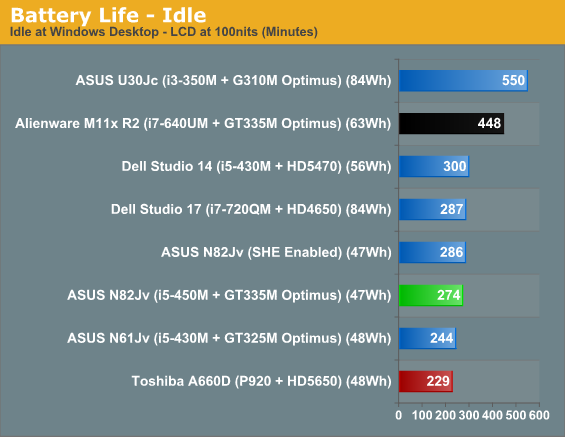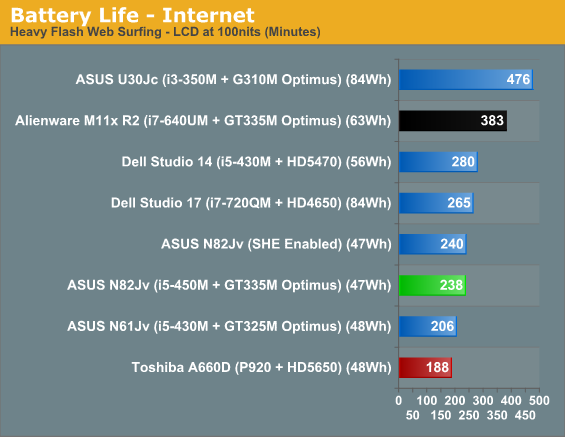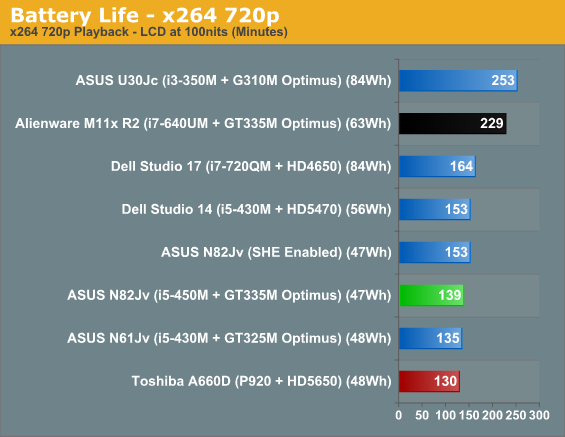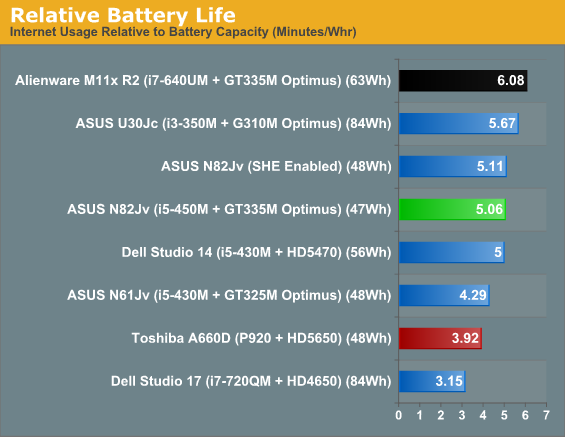ASUS' N82Jv: Jack-Of-All-Trades
by Jarred Walton on September 11, 2010 11:10 PM ESTASUS N82Jv-X2 Battery Life: Win Some, Lose Some
We've loved ASUS' idea of stuffing large 8-cell batteries into their U-series laptops. Unfortunately, the N82Jv we received for testing came with a standard 6-cell, 4400mAh battery. Given the use of Optimus, the only thing separating the N82Jv from the mobility results of the U30Jc is the battery, which means the U30Jc provides significantly more untethered usability. ASUS has a utility/feature called their Super Hybrid Engine (SHE) that drops the CPU multiplier down to 9x/10x instead of letting it float from 9x up to 20x, which can boost battery life a bit but not nearly so much as the decreased performance would lead you to expect. Then again, we use the Power Saver profile with maximum CPU set to 50%, so we've already limited CPU performance in the pursuit of battery life….




The N82Jv manages to best the larger N61Jv in each of the battery tests, mostly because of the smaller LCD. The lead is 12-15% in our first two tests, but it drops to just 3% in x264 playback—likely because of the higher CPU clock. Notice how SHE also helps the most in the x264 test, where battery life is improved 10% compared to just 1-4% in the other two tests. The results of the Dell Studio 14 are a bit higher thanks to its larger 56Wh battery; 19% more battery capacity results in 10-17% more battery life, meaning the ASUS N82Jv is actually more power friendly but it's hampered by the low capacity battery. If we look at the U30Jc we see what might have been. Yes, it has a smaller 13.3" panel, a slower i3-3350M CPU, and a 5400RPM hard drive, but it provides 80 to 100% more battery life from a 78% increase in battery capacity.
As a final comparison, look at what Intel i5 + Optimus (i.e. Intel HD on battery power) can do in comparison to AMD's P920 + HD 4250. We're looking at the same battery capacity, so this is really just Intel's mobile platform going up against AMD's platform—though the A660D does have a larger 16" LCD. The N82Jv is at its best in the Internet test, where it provides 27% more battery life than the A660D. AMD on the other hand appears to do quite well on the x264 test, coming within spitting distance of the smaller laptop—and very possibly, a 14" LCD would have made up the gap.
In the end, we're looking at just over two hours of battery life for HD video playback and up to four hours (4.5 with SHE enabled) maximum—if you shut down all extraneous services and applications, at least. While that's not terrible, neither is it stellar. ASUS' website lists an 8-cell battery option, and we really wish they—and all other midrange notebook manufacturers—would quit with the 48Wh batteries. We know they're cheaper, and a 6-cell battery weighs a bit less than an 8-cell, but rather than going for so many different product lines it would be nice to see ASUS focus on doing fewer models but getting them right in all areas.










33 Comments
View All Comments
JarredWalton - Monday, September 13, 2010 - link
See page two... added the HWMonitor screenshot and some commentary (similar to the above).The Crying Man - Monday, September 13, 2010 - link
Really? Why shouldn't people play games on notebooks? I've been doing it for over 8 years without problems.seanleeforever - Monday, September 13, 2010 - link
gaming on a laptop is full of compromises. you never get a powerful enough CPU/GPU without paying penalty of weight/battery life/heat/noise/price. and two years later, you laptop is out of date and you have NO ABILITY to upgrade it.i am no stranger to notebook gaming. i had that very goal when i entered college (which was many, many years ago). i bought the most powerful notebook with best graphic card available. the system cost over 2k with coupons (which was VERY expensive, i might add). it was high price/heavy weight (5.2 lbs)/heats up like crazy, and poor battery life. it was out of date by the 3rd year in college and barely run any new games with decent settings.
Then, i bought another one (T61P) when it came out, again, the best graphic card in business and expensive like hell. it run games great in that year, but now cannot even run SC2 with medium settings.
the inability to upgrade is really what kills it. when you buy notebooks, you are paying more than Ram/HDD/CPU/GPU. you are paying the whole package. buying a gaming laptop means once the CPU/GPU is out of date, you gonna have to throw the whole thing out, no matter how great the monitor you have, no matter how good the keyboard is, no matter how awesome the system was designed. Notebook manufacture knows about it. they cheapens the design in other areas because they know you gonna move to new gears once Intel/AMD/Nv's new chip is out. long term reliably is no longer a concern (HP, i am looking at you). long term engineering test is complete out of the window because all it matters is to ship the units with the newest chip (the ENTIRE NV lineup were overheating, any body?)
i really love the way desktop works. i can dump a lot of money on a good monitor, keyboard, mouse, cage, audio, and knowing those parts are staying with me no matter i upgrade my system to i7 or i70.
the only thing that keep pushing for new notebooks are games. i can hardly find any reason to dump my T61P besides gaming performance. the new i7 cores are also extremely good (i only have i7 620lm, but it runs 1080 video, VHDL simulation, and matlab code without a problem). so this time around i dumped money into a well designed, ultra portable tablet with one of the best screen in business that i know i will use for the next 5 years. meanwhile i can built myself a gaming machine if i wanted for 30% of the cost.
JarredWalton
believe or not, a lot of people buying notebook not for gaming. i know anand has received a lot of computers in the past, why not create a lab to test
1: sound quality? fan noise?
2: screen quality? (like, take picture from all angels and compare it to others), screen reflection. out door view experience.
3: actual portability. when you travel (the reason for thin and light notebook), you want to work on the go. does the position of the fan make it easily blocked when playing on your lap or other soft surfaces? does it make machine overheat? effect on fan noise?
4. ease to use, such as how accessible is to the HDD and RAM? how difficult it is to do a full on re-store to factory setting? how about drivers support if your HDD is broken and you do not have a DVD shipped with system? how easy to make back on your person files using the provided tool? and how about notebook specific functions (like, if you have thinkpad, you have thinkvantage software that actually does some nice things such as check your system health, check your drivers and install them automatically).
my whole point is that there is SO MUCH MORE to tell other than your new notebook can run crysis and last 5 hours. in fact, gaming performance is maybe what i care the least because as soon as i see the GPU and CPU, i have a good feeling of what this can and cannot do. the Toshiba one is nicely done to point out the crapware that came pre loaded.